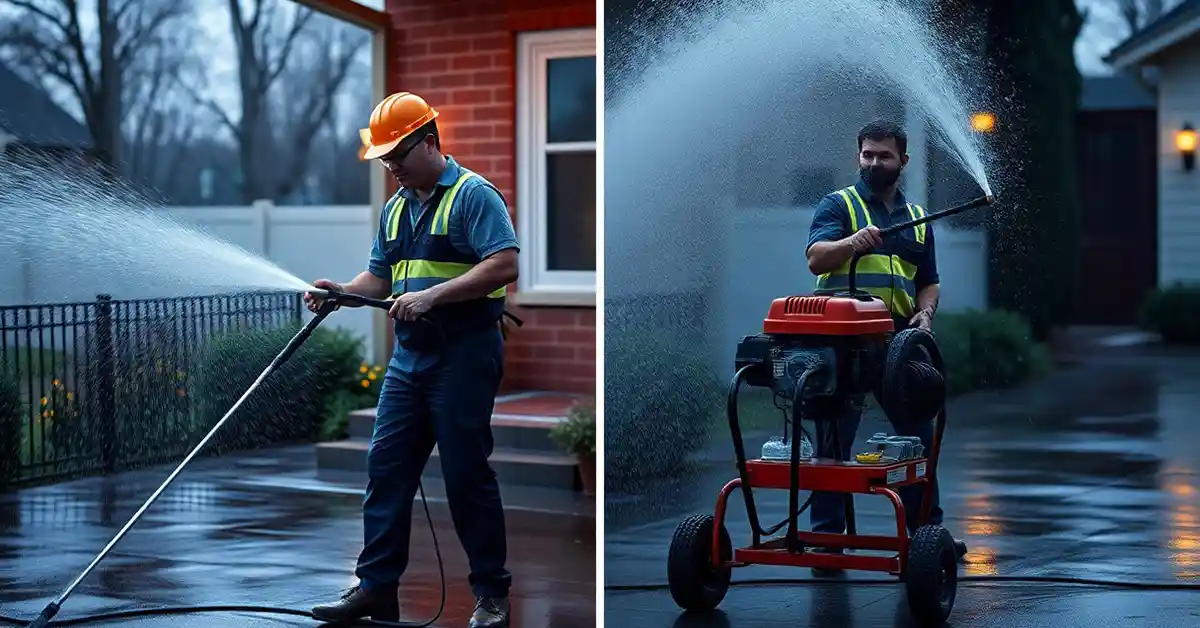Exterior cleaning plays a vital role in maintaining the beauty, safety, and longevity of your property. Over time, surfaces such as siding, driveways, patios, and decks accumulate dirt, mold, mildew, grease, and grime that regular cleaning can’t handle. That’s where pressure washing and power washing come in.
Although the terms are often used interchangeably, they are not the same. Homeowners, property managers, and contractors frequently ask: What’s the difference between power washing and pressure washing? The short answer lies in water temperature—but there’s more to it than that.
This guide breaks down everything you need to know: the definitions, differences, applications, pros and cons, costs, and safety tips for each method.
Defining Pressure Washing and Power Washing
Pressure Washing
Pressure washing uses high-pressure cold water to blast away dirt, mold, mildew, pollen, algae, and other surface-level contaminants. It is one of the most common residential cleaning methods because it’s safe for most materials, cost-effective, and highly efficient.
Power Washing
Power washing also uses high pressure, but the difference is in the heated water. The combination of hot water + pressure makes it more effective at tackling grease, oil stains, chewing gum, salt, and stubborn grime that cold water alone cannot remove.
Because of the heated element, power washing is typically reserved for tough cleaning jobs in commercial and industrial environments.
Key Differences Between Power Washing and Pressure Washing
While both methods clean surfaces with forceful streams of water, here’s where they differ:
-
Water Temperature:
-
Pressure washing = cold water.
-
Power washing = heated water for deep cleaning.
-
-
Applications:
-
Pressure washing is perfect for siding, patios, decks, driveways, fences, and general dirt or mold.
-
Power washing works best for grease, oil, salt, chewing gum, or industrial mess.
-
-
Equipment:
Power washers have heating systems, making them bulkier and costlier compared to standard pressure washers. -
Surface Safety:
Pressure washing is versatile and safer for more delicate materials. Power washing can damage wood, vinyl, or painted surfaces if not handled correctly.
When to Use Power Washing
Power washing is the right choice when dealing with:
- Grease and Oil Stains: Particularly on driveways, garages, or industrial floors.
- Chewing Gum Removal: Heat softens gum, making it easy to wash away.
- Salt and Grime Build-Up: Essential for winter cleanup in colder climates.
- Commercial and Industrial Spaces: Warehouses, factories, and sidewalks exposed to heavy traffic.
Tip: Because of its intense cleaning power, power washing is best left to professionals who can adjust PSI settings and water temperature safely.
When to Use Pressure Washing
Pressure washing is suitable for routine home maintenance and general cleaning tasks, such as:
- Vinyl Siding and Brick Walls: Removes dirt, mold, and mildew safely.
- Wood Decking and Fences: Refreshes weathered wood (when done with the right PSI).
- Concrete Driveways and Patios: Blasts away dirt, mud, moss, and stains.
- Outdoor Furniture and Walkways: Keeps patios and gardens clean and inviting.
Since it doesn’t involve heated water, pressure washing is safer for more delicate surfaces and easier for homeowners to DIY.
Pros and Cons of Each Method
Pressure Washing
Pros:
-
More versatile and suitable for most surfaces.
-
Affordable and accessible equipment.
-
Eco-friendly when used with just water.
Cons: -
Less effective against grease or oily stains.
-
May require detergents for tough jobs.
Power Washing
Pros:
- Extremely effective on stubborn stains.
- Ideal for commercial and industrial cleaning.
- Hot water sanitizes surfaces by killing bacteria and algae.
Cons: - Expensive equipment and higher service costs.
- Can damage siding, wood, or paint if misused.
- Not always necessary for residential cleaning.
Safety and Surface Considerations
Both methods use high pressure, which can cause damage if not handled properly.
- Water Pressure Settings: Too much PSI can strip paint, etch concrete, or splinter wood.
- Protective Gear: Safety goggles, gloves, and boots are essential.
- Surface Damage Prevention: Test a small area before cleaning large sections.
- Professional vs DIY: Hiring a pro ensures the right method and PSI are applied for each surface type.
Surfaces to Avoid:
- Asphalt roofing shingles (can strip granules).
- Old wood that may splinter.
- Lead-based painted surfaces.
Cost Comparison and Value
Many homeowners wonder about the cost difference between power washing and pressure washing.
- Average cost of pressure washing: $150–$400 (residential jobs).
- Power washing prices: $250–$600 (because of specialized equipment and heating systems).
Factors affecting cost:
- Size of the area.
- Type of surface.
- Stain severity (oil, grease, mold).
- Regional labor costs.
Although power washing is more expensive, it may save money in the long run for heavy-duty jobs by reducing the need for repeated cleaning.
FAQs: Clearing Up Common Misconceptions
Can I use pressure washing instead of power washing?
Yes, for most residential tasks like siding, patios, and decks.
Is power washing always better?
No. Power washing is stronger but riskier. It should only be used when necessary.
Which is more eco-friendly?
Pressure washing is more eco-friendly because it often relies on water alone, without heat or detergents.
Can either be used on roofs?
Neither method is ideal for traditional shingle roofs. Soft washing is a better, low-pressure alternative.
Conclusion
So, what’s the difference between power washing and pressure washing? It comes down to water temperature and application needs.
- Use pressure washing for routine maintenance and general cleaning.
- Use power washing for stubborn stains, grease, or commercial-grade messes.
Choosing the right method ensures your property looks clean, surfaces remain intact, and long-term maintenance costs stay low. For large projects or delicate materials, consulting a professional cleaning service is always the safest choice.


